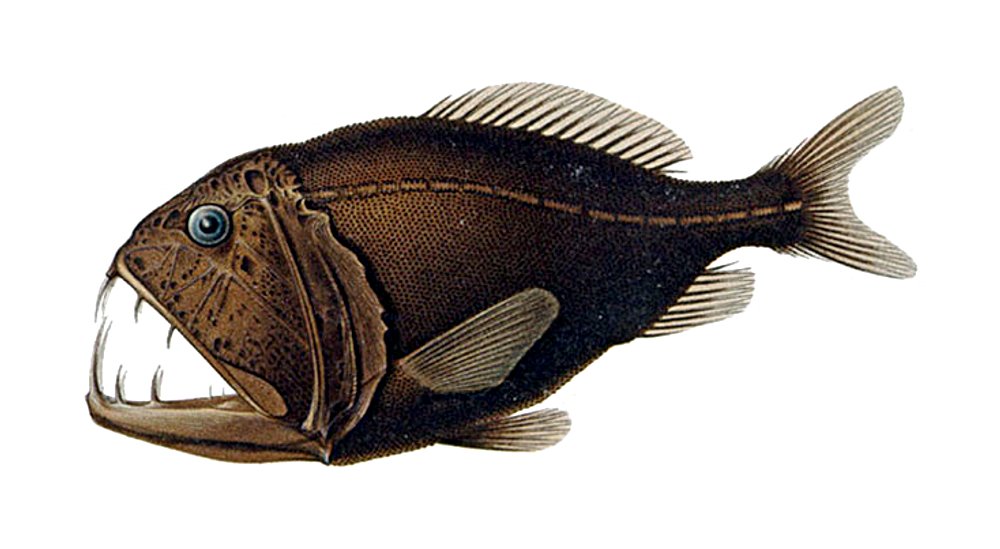Common Fangtooth (Anoplogaster cornuta) - Wiki Fangtooth
From Wikipedia, the free encyclopedia
[Photo] A. Brauer, "Die Tiefsee-Fische. I. Systematischer Teil." In Carl Chun, Wissenschaftliche Ergebnisse der deutschen Tiefsee-Expedition auf dem Dampfer ″Valdivia″, 1898???1899 (Jena: G. Fischer, 1906).
Fangtooths, also known as ogrefishes, are deep-sea, ferocious-looking beryciform fish of the family Anoplogastridae (sometimes incorrectly spelt "Anoplogasteridae"). With a circumglobal distribution in tropical and cold-temperate waters, the family contains only two very similar species with no known close relatives: the common fangtooth, Anoplogaster cornuta, found worldwide; and the shortthorn fangtooth, Anoplogaster brachycera, found in the tropical waters of the Pacific and Atlantic Ocean.
Physical description
While understandably named for their disproportionately large, fang-like teeth and unapproachable visage, fangtooths are actually quite small and harmless to humans: the larger of the two species, the common fangtooth, reaches a maximum length of just 16 centimetres (6 inches); the shortthorn fangooth is about half this size.
The head is large with a huge maw and appears haggard, riddled with mucus cavities delineated by serrated edges and covered by a thin skin. The eyes are relatively small, set high on the head; the entire body is a dark brown to black and is strongly compressed laterally, deep anteriorly and progressively more slender towards the tail. The fins are small, simple, and spineless; the scales are embedded in the skin and take the form of thin plates. As compensation for reduced eyes, the lateral line is well-developed and appears as an open groove along the flanks.
In adults, the largest two fangs of the lower jaw are so long that the fangtooths have evolved a pair of opposing sockets on either side of the brain to accommodate the teeth when the mouth is closed. The juveniles are morphologically quite different - unlike the adults, they possess long spines on the head and preoperculum, larger eyes, a functional gas bladder, long and slender gill rakers, much smaller and depressible teeth, and are a light gray in colour. These differences once caused the two life stages to be classed as distinct species, with one in another genus; Caulolepsis.
Ecology
The pelagic fangtooths are among the deepest-living fish, found as far as 5,000 metres (16,400 feet) down. They are more commonly found between 200 - 2,000 metres (660 - 6,560 feet) however, and juveniles apparently stay within the upper reaches of this range. They may undergo diel migrations as is common with many deep-sea fish: by day these fish remain in the gloomy depths and towards evening they rise to the upper layers of the water column to feed by starlight, returning to deep water by daybreak. Fangtooths may form small schools or go it alone; they are thought to use contact chemoreception to find prey, relying on luck to bump into something edible.
The smaller teeth and longer gill rakers of juveniles suggest they feed primarily by filtering zooplankton from the water, while the deeper-living adults target other fish and squid. The fangtooths' oversized teeth and mouths are a common feature among the miniature beasts of the deep (cf. viperfishes, daggertooths, bristlemouths, barracudinas, anglerfishes), thought to be an advantage in these lean waters where anything encountered (even if it is larger than the fish) must be considered a possible meal. The fangtooths in turn are preyed upon by other large pelagic fish, such as tuna and marlin.
Fangtooths are known to be robust when compared to many other deep-sea fish; they have been kept alive for months in aquariums despite conditions which are significantly different from their natural habitat.
Reproduction
Fangtooths have planktonic larvae and are assumed to be non-guarders; spawning frequency and time are not certain, but some activity has been reported from June???August. The juveniles of common fangtooths begin to assume adult form from about 8 centimetres (3 inches) in length, at which time they begin to descend into deeper water. Onset of maturity is not known, but common fangtooth are known to be mature at 13 centimetres (5 inches). They are probably slow-growing, as are most deep-sea fish.
http://en.wikipedia.org/wiki/Fangtooth
| The text in this page is based on the copyrighted Wikipedia article shown in above URL. It is used under the GNU Free Documentation License. You may redistribute it, verbatim or modified, providing that you comply with the terms of the GFDL. |
